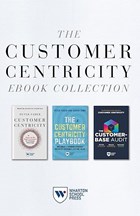We all remember the times we have received bad customer service. Good customer service, as it’s expected, rarely registers. What we also notice is the annoying sales pitches for things we have absolutely no interest in, and conversely those brands that really pay attention to who we are and what we are likely to want.
Companies must of course eliminate customer service negatives, but ‘customer centricity’ is confusingly not entirely about customer experience—at least not directly. Being customer-centric is about creating personalized, fruitful, and sustained relationships with the ‘right’ customers—cutting out wasteful promotional expense—anticipating customers’ wants, helping them make decisions in their best interest, and tailoring products and services to their real needs and desires.

The term ‘customer centricity’ has been around for decades. Today, with the assistance of advanced improved data analytics, this key to competitiveness is easily within the grasp of businesses of all types. So it is timely and welcome that The Wharton School Press is launching The Customer Centricity E-book Collection. This compendium of three e-books—from Wharton School’s Peter Fader, London Business School’s Bruce Hardie, data agitator Michael Ross, and Sarah Toms from IMD—provides an authoritative guide to understanding, implementing, and measuring the impact of customer-centric strategies.
Before data-driven customer-centric thinking became established in marketing minds, the product was king. Product centricity was best exemplified by Apple, when it bucked the tecno-nerd norm and focused its product development, not on the technology, but on elegant functional design. Successful up to a point, Apple’s success was based on the genius of its founders and their ‘we know best outlook.’ Yet, Apple remained fundamentally detached from its customers—happy and loyal as they may be.
Customer centricity takes a diametrically opposed, ‘customer knows best,’ approach and, more than that, it focuses on knowing who the right customers are—not bothering the wider uninterested community. In Peter Fader’s foundation book—first edition published in 2011—he states: “The customer isn’t always right. The right customer is always right. And yes, there is a difference.”
As well as the product-first approach being over-empathized, the marketing world has for years been bedeviled by a protracted argument over which is best way to achieve top-line growth: investing to build the widest possible customer base, or squeezing the maximum revenue from existing customers on the theory that it is much less costly to retain a customer than to acquire one. Customer centricity sees this as a false dilemma. Loyal customers must of course be served as well as possible, but it is by examining the behavioural patterns of current customers, through sophisticated data analysis, that a company can find new ‘right’ customers.
The quality of the data gathered from customer-centric initiatives, the perceptiveness of the data analysis, and the commitment to base strategic decisions on the findings, are the drivers of a customer-centric enterprise. They are the means to both satisfy loyal customers and to identify new ones. While, the basic concept has been around for decades, with just a few tweaks to improve it, the tools available to implement it have radically changed. Advances in data analytics enhanced by machine learning and AI not only strengthen the capability of customer centricity but put it firmly in the reach of companies of all types and sizes. Beyond this the channels of communication and ability to reach individual customers with precise targeted messages has greatly expanded with the growth of social media.
In a business world that is increasingly competitive and complex, and with the call for leaders to address a wide range of regulatory, ESG and other non-commercial issues, developing savvy marketing strategies is critical. Customer centricity can be the basis for this. The Customer Centricity E-book Collection, from The Wharton School Press offers business leaders a valuable guide to the concept, laced with illustrations of how a wide variety of real business have successfully implemented and benefitted from customer centric strategies.


































